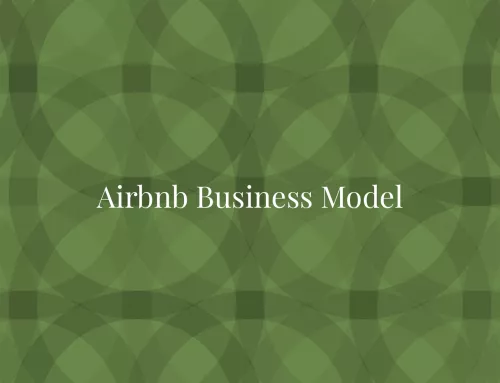Customer Journey Maps are structured, collaborative tools to linearly map the experience of your customers & strategically develop those experiences. This tool can be broadly applied to a client’s overall experience your professional service firm. Using this tool, you can focus on a specific product or service too. If required, you can deep-dive in on specific features or service aspects for fine granularity. Subsequently, you can analyse the findings to identify potential shortcomings in your product / service offerings that your customers value. Using these insights, you can then articulate a coherent improvement plan, which should lead to satisfied clients.
Benefits of Customer Journey Maps
Customer Journey Maps help understand & visualize what your customers are experiencing and feeling throughout their journey with your product / service. Customer Journey Maps will help you empathize with your customer & improve your understanding of their needs. Better empathizing with your users is a gift that keeps on giving. It will help you make product road map decisions that will increase customer satisfaction. Moreover, this information will help you identify places to improve the user experience and retain more customers. In other words, Customer Journey Maps provide an excellent visualization of the larger context of the customer experience, as opposed to just focusing on your products / services. David Weaver, co-founder of Vintage Cash Cow, explains the benefits of Customer Journey Maps as:
A successful customer journey map will give you real insight into what your customers want and any parts of your product, brand or process that aren’t delivering.
If you could also involve your customers in this process, they will undoubtedly appreciate your commitment to their satisfaction and happiness over time. By going through the journey mapping process, you can learn from customer experiences and make product or service improvements to better meet their needs. In practice, Customer Journey Maps are extremely valuable tools for making decisions and finding client-centric solutions.
Types of customer journey maps
There are a few different types of customer journey maps based on what your specific goals are: current state, future state, and day in the life mapping. All four of these types of customer journey maps can be very helpful depending on your business goals.
Current state mapping
This customer journey map paints a picture of how customers are interacting with your product or service right now. It is based largely on customer data and observational research. This type of customer journey map is well-suited to helping you better empathize with your customer and diagnose areas where you can improve their experience.
Future state mapping
This customer journey map is a representation of the ideal journey you’d like customers to take as they experience a brand. In short, this activity is all about conceptualizing and visualizing new experiences for your customers. It can help close the gap between where the user experience is today and where it should be in the future. Usually, you perform this activity after the current state mapping exercise. Realistically, you should fully understand the current state before envisioning the future state & recommending improvements to reach the ideal state.
Day in the life mapping
This is a representation of all of the day-to-day activities your ideal customer takes in their daily life. The scope could be quite broad beyond the normal use of a product or service. This is a helpful map for understanding the larger context & identifying additional analyses that provide client benefit / value.
Competitor’s Journey Map
This is a benchmark journey map that you may also want to create. These can be useful to determine & visualize how your client compares to other industry peers. This type of map can also be a solid source of inspiration. Understanding competitors’ solutions & journeys can highlight the differences, identify what your client’s differentiators are and encourage you to think about strategies to improve the overall experience of their customers.
Developing Customer Journey Maps
Overview
The structure for developing Customer Journey Maps is always the same. The main phases of the customer experience are shown on the horizontal axis. This is like the AIDA model (Attention Interest Desire Action). However, when developing Customer Journey Maps, we will skip the customer relationship aspect of the AIDA model. This is because we are representing a very generic customer life cycle through these maps & adding the relationship dimension will introduce additional complexity. Here’s the sanitized template I used for a recent Retail Sales Strategy development engagement for a luxury automotive OEM.
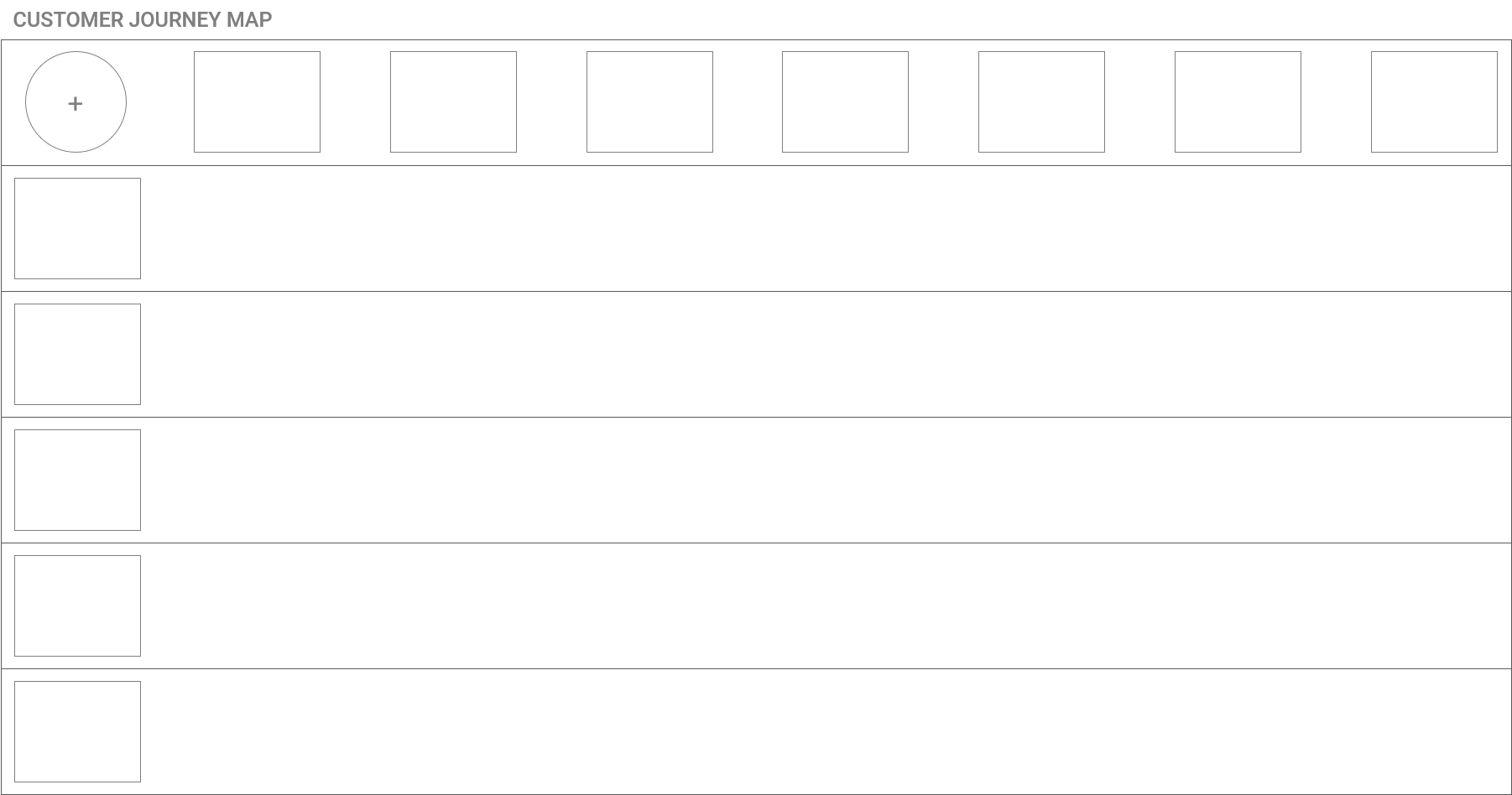
For this engagement, I used these phases:
- Attention (how does the customer become aware of us?)
- Interest (how do we arouse the customer’s interest?)
- Purchase (how exactly does the purchase work?)
- Ownership (what are typical ownership phases?)
The vertical axis is composed of the so-called swim lanes. Some examples of swim lanes are:
- Thinking (what are the customer’s thoughts and questions?)
- Feeling (what are the emotions the customer has?)
- Act (what exactly does the customer do?)
- Data (what data do we have, what do we know about the customer?)
- Ideas (what are our first ideas?)
- Initiatives / projects (which projects already exist that start at this point in the journey?)
Customize these phases & the swim lanes based on the engagement scope & objective. I recommend starting somewhere in the middle when populating the map. Customer experience is highly non-linear. Hence, you don’t have to stubbornly work through the journeys in a specific order.
Set the scope & objectives
Before you start creating your map, you need to ask yourself why you are making one in the first place:
- What goals are you directing this map towards?
- Who is it specifically about?
- What experience is it based upon?
Once you’ve decided on your goals for creating a customer journey map, you can begin choosing the cross-functional team who will come together to create the map. Keep in mind that different departments all engage with customers differently and can provide unique pieces of the puzzle that you would likely not find without their presence.
Choose a persona
Based on this, you may want to create a buyer persona. This is a fictitious customer with all of their demographics and psychographics. The persona represents your average customer. Having clear personas helps direct your focus to all the essential aspects of your target customer(s). Based on research and data from your existing customers, a persona is a heuristic that represents an essential segment of your buyers. Limit journey maps to the experience of one persona and their path toward one primary goal. If you try to capture every single customer and every journey they take in one map, you’ll miss the signal in the noise.
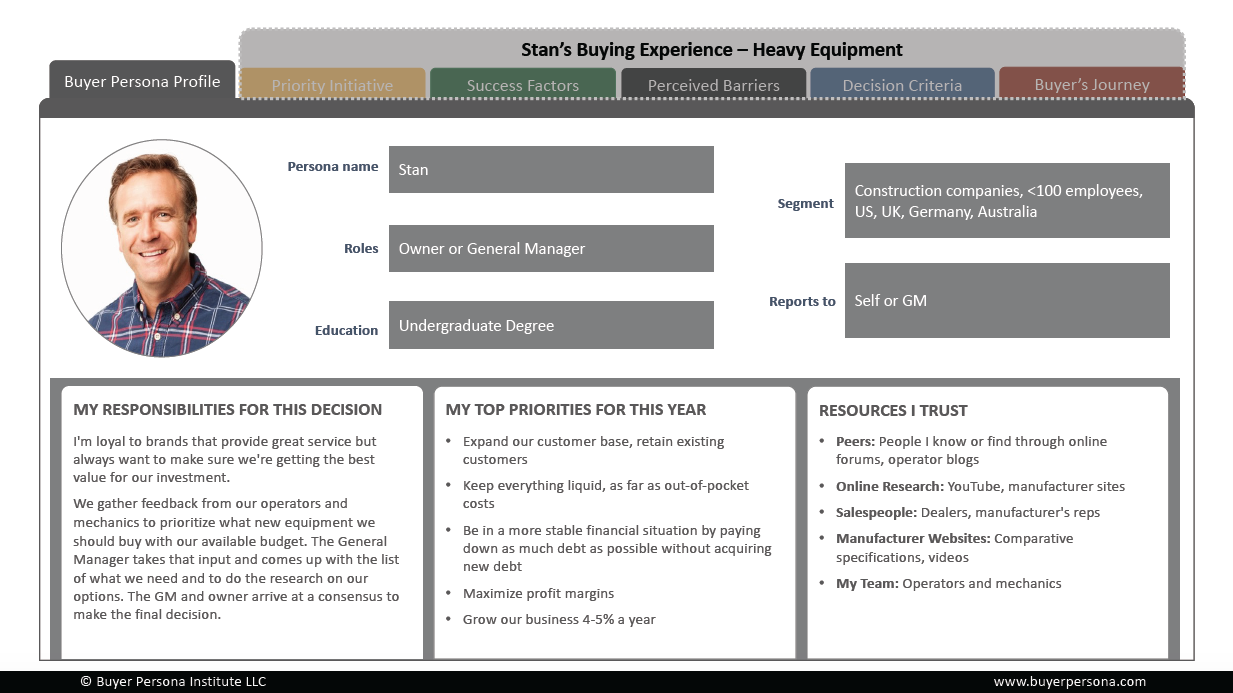
Persona Example
A Customer Journey Map almost always focuses on the experience of one main actor. This could be a group of customers or employees. Some journey maps also combine various perspectives into one map. For example, a journey map may compare different customer groups or customer experiences with those of employees at some service moments. In any case, you should choose a persona that you want to understand. Start by clearly defining:
- Who your persona is
- What his / her expectations & needs are
- What do customers want to achieve as they move through each stage?
This activity strongly influences how you will interpret the Customer Journey Maps that you are creating. Hence, this may be the most critical—and, in some cases, most difficult—step. To make things easier, you can leverage a number of data sources to get that information, such as:
- Survey
- User tests
- Interview transcripts
- Customer service emails
- Support transcripts
Plot the touch points
Think of touch points as places where customers engage with your brand. These are the interfaces that you should support to help your clients complete their goals. Subsequently, you will group the touch points under the relevant stage of your customer’s journey. For retailers, a common touch point might be a product description page on a website. For a professional service business, it may anything from a pricing page, whitepaper or even a contact form. Start by creating a list of all the different ways a customer can interact with your brand. The more detailed & specific you can be with this list, the more detailed, specific & accurate your Customer Journey Map will be. If you use Google Analytics, you can identify the touch points along the user journey in two reports:
- Behavior Flow report
- Goal flow report
The Behavior Flow report shows how users move from one page or event to the next. It can help show you where users struggle to get where they want to go on your site. You can segment traffic by any dimension, then analyze specific steps in the flow by mousing over them. The Goal Flow report helps you see whether users are completing a goal of your choosing through a funnel. You’ll be able to determine if users—or a subset of them—are unexpectedly leaving in the middle of their journey on the path to the goal, or if there’s a place where your traffic loops back.
Phases of the Purchase Journey
This section details the process customers follow from awareness, to purchase, and beyond. In real life, this isn’t a straight line & different parts might overlap. However, for the sake of developing Customer Journey Maps, we will divide the journey into discrete steps. The number of steps you require depend on the industry, product & customer type. For example, a business-to-business procurement journey will look very different from someone thinking about planning a wedding ceremony.
Add details
After having defined the sequence of phases, you add various visualizations to build the actual content to your journey map. As mentioned before, you can add swim lanes to your journey map to show or analyze different parts of the experience. You can also enrich the journey map with additional details, such as personas’ emotions, channels, etc. When developing Customer Journey Maps, you should think about the trade off between the overview perspective & the important details that might be of value for customer-centric improvements. You don’t need to deep dive into all areas when you start out. However, you should be able to dig into the details to prioritize the next steps. Some of the essential details you can collect at this stage are:
Customer Thoughts and Actions (Verbatim)
Capturing the combination of what customers do, think, and feel is why journey maps are so useful. Customer verbatim (quotes) help us understand customers’ perceptions. It also gives us a steer on where we should start improving the experience. Verbatim paint a more vivid and compelling picture of your customers and their experiences
Pain Points
Here, we capture the most significant issues that customers have when pursuing their mission. Each pain point will be bucketed into a part of the Purchase Journey. We’ll then associate it with a touch point or lack thereof. While performing qualitative research, you’ll find that customers are honest about their complaints. The challenge will be using data and further analysis to decide which of these to include
Emotional journey
This is the secret sauce that makes customer journey maps, especially helpful. By understanding the peaks and valleys in your customer’s emotional journey, you’ll identify those areas for improvement
Opportunities for Improvement
This section is where you can build on the pain points, emotional journey, and customer feedback to start painting a picture of the future. Often these areas act as thought starters for more robust research projects or analyses
Workshops
Begin filling out your customer journey map in a workshop style. This is the part where your team can begin compiling everything that your research has found and start creating a visualization to represent it. This should be a workshop style session where ideas are shared and discussed freely
Moments of truth (MoTs)
These are one of the most important elements in your map. These are the aspects of your product or service that are the most important to your user. MoTs define how the user will feel about their entire experience with your product or service. These moments will determine if they return to repurchase your product, if they recommend it to others, and in extreme situations whether or not they will take the time to publicly criticize your product or company online. For this reason, you should prioritize MoTs as the most important moments to provide a positive experience. In total, you should land on 1 or 2 moments of truth. If you have particularly complex customer journeys, 3 should be the maximum amount of MoTs
Emotions
The most important part of the map is the actual emotional experience:
- Can the user easily see how much he will pay for the highest plan?
- Or does it take users a long time to find this information on your website?
- Can users easily submit their CV to apply to the role via your website?
- Do customers have to fill in a lengthy form asking questions that are typically covered in the CV anyway?
- Is there a bug in your code and your users cannot use the features they want in the dashboard of the tool?
The easiest way to mark the experience on your map is to draw a horizontal line and put a mark above it for positive experiences, at the line for neutral experiences, and below the line for negative experiences. You can also use scoring (for example from +5 to -5) – the higher on the positive side the marks will be for specific actions and/or touch points the more positive the experience.
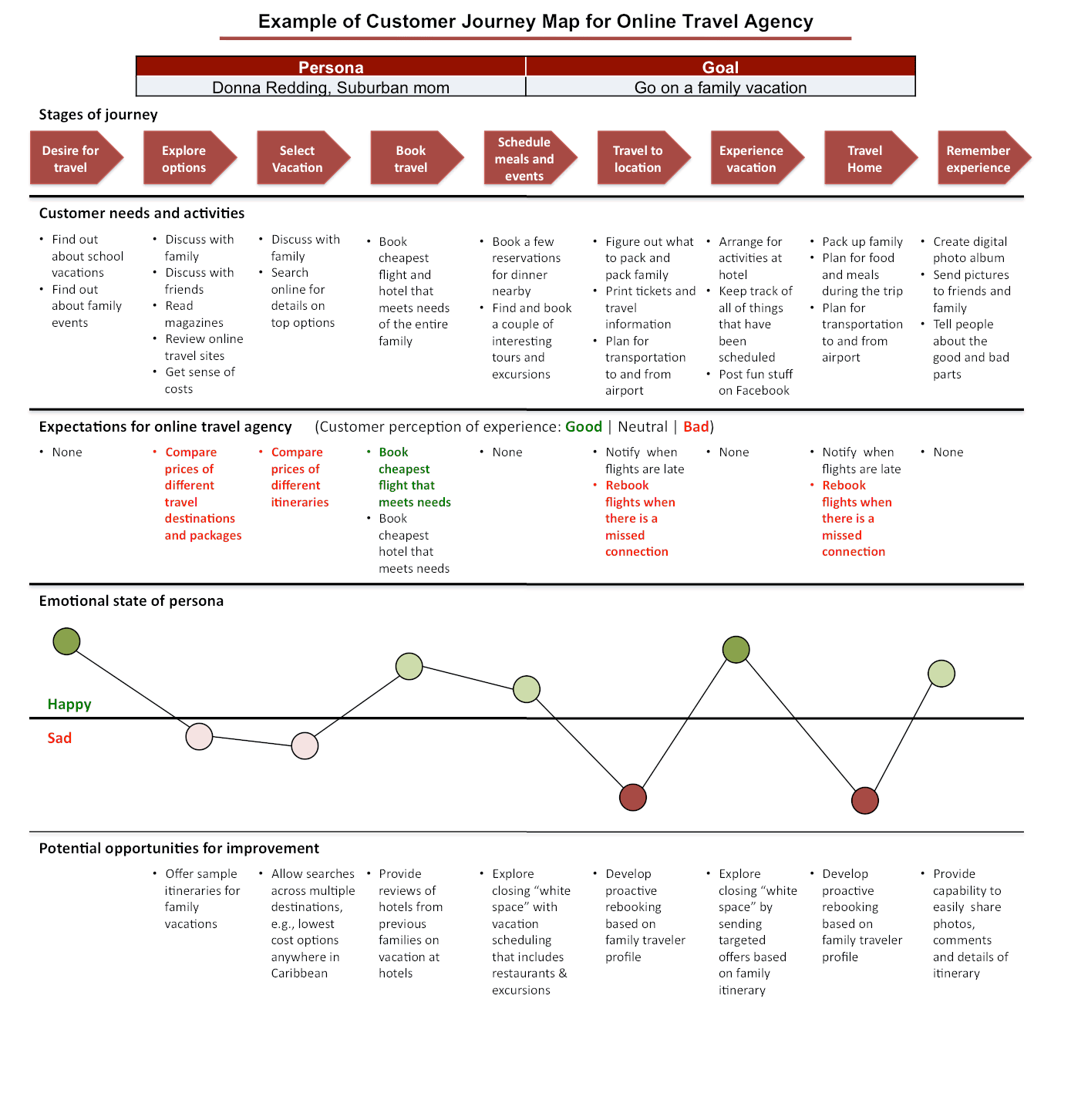
The lower below the line, the more negative the experience. This will allow you to quickly identify moments within their journey where your customers are struggling and moments where they’re delighted. In other words, this will help you see opportunities to improve the experience by improving specific points during the journey. But don’t get out your whiteboard just yet! There are a couple more things you can do.
Positive vs. negative experiences is of course a simplified approach that’s intended to help you assess the situation very quickly by just glancing at the map. But you can always add an additional layer and try to determine what emotions exactly your customers are feeling. If their experience is negative – are they feeling angry or sad? Or maybe anxious or disgusted?
Quantify & implement metrics where possible
While this step isn’t always included in Customer Journey Maps, I recommend including it, wherever you can. Try to apply metrics to the columns in your map. Sometimes it won’t be possible. But, whenever it makes sense, try to come up with metrics that will help you measure the impact of the change you will implement. Some of these metrics are probably used in your business already. For example, shopping cart abandonment is a common metric for eCommerce companies. But, don’t be afraid to introduce new metrics as long as they make sense. For example, measure the percentage of customers seeking help with your support team during the on boarding process. Once you have metrics it will also be easier to see which department is responsible for this element to increase accountability when implementing the changes.
Analyze your findings
Once you’ve determined whether the experience in each event or touch point is positive or negative for your user, and you’ve identified MoTs, you will naturally be able to nail down the opportunities all this creates to improve your product and make it more consistent across touch points, easy to use and sticky. In other words, what can you do to improve a negative experience, or even delight the customer in each event?
Opportunities may be quite detailed like reducing the number of steps in the purchasing process, providing status updates, providing more concise messaging or making it easier to find contact details to your support team. Write down all of these opportunities. You can decide later which ones to focus on. Some of these may be too time or resource intensive. So, you don’t need to attack them all at once. As with everything, prioritization will be important.
Prepare to iterate
Customer journeys are not scientific methods. So, there is no right or wrong approach to creating Customer Journey Maps. Nevertheless, you should clearly define the scope & objectives up-front. This helps you design the purpose, layout & data collection workshops with clients & other stakeholders. Subsequently, you can easily prioritize the next steps. Sometimes, you may find that customer perspectives don’t always properly overlay. This could be the case of your trying to put too much into a journey. Under such circumstances or when you’re in doubt, create several journeys!
Avoid the temptation to fixate on being perfect, or even exhaustive. A Customer Journey Map is never going to be 100% accurate or even complete, even with the best tools. The best you can do is strive to be as thorough as possible without impeding progress. Nevertheless, an imperfect or even incomplete customer journey map is better than no map. Besides, this is an iterative process. You can and should return to your customer journey map and add missing elements or new insights.
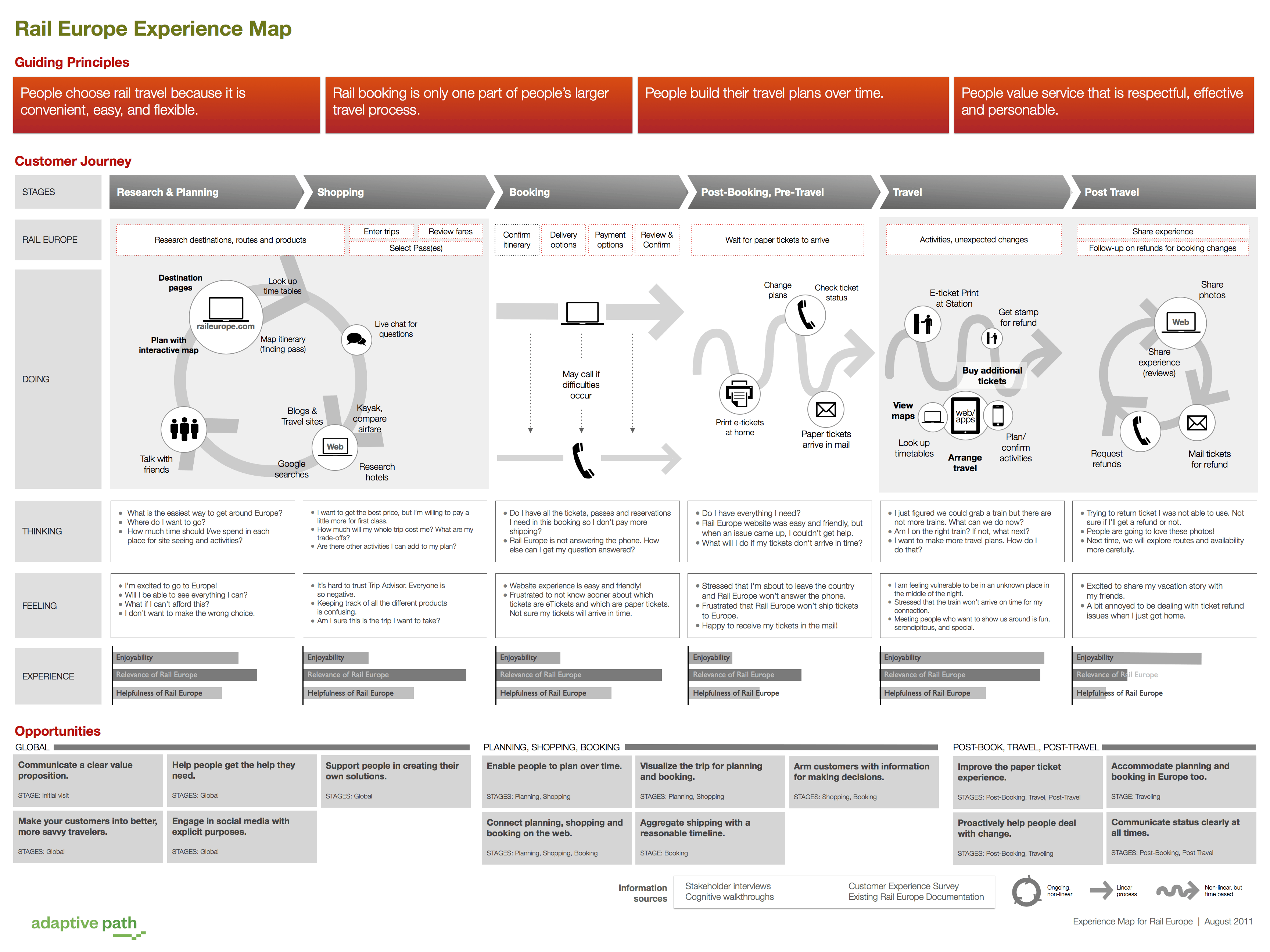
Sample Customer Journey Map For RailEurope
Next Steps
Throughout this process, you would likely have identified some shortcomings that need remediation. Consequently, you should help the client formulate a plan to address newly uncovered issues. Be mindful of establishing ownership for these follow-up fixes. If overlooked, holding people accountable will be difficult.
Though creating the Customer Journey Map should have been an inter-disciplinary exercise, you should still notify the relevant stakeholders across the entire company. You need to ensure that they understand the importance & implications of the changes you’re advocating. In this regard, Customer Journey Maps are excellent communication tools that not only put everyone on the same page, but also help gain buy-in for necessary changes from stakeholders.


